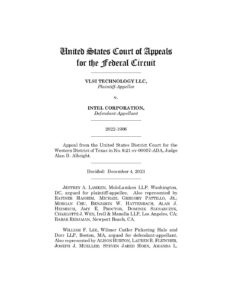By David Madio
VLSI v Intel has been in the public eye at least since a Texas jury awarded VLSI the largest patent infringement verdict to date, a total of $2.175 billion for two patents. In April 2019, VLSI sued Intel for infringing certain claims of U.S. Pat. Nos. 7,523,373 (“Minimum Memory Operating Voltage Technique”) and 7,725,759 (“System and Method of Managing Clock Speed in an Electronic Device”) in the U.S. District Court for the Western District of Texas.
The ’373 Patent
The ’373 Patent describes an integrated circuit that includes a memory and a processor. The memory requires a minimum operating voltage. When the processor is in a low-power state such that the voltage is lower than the minimum operating voltage of the memory, the memory switches over to a higher voltage than the processor.
VLSI alleged that Intel’s Haswell and Broadwell microprocessors infringed the ’373 Patent.
The Federal Circuit affirmed the decision in the district court, which found literal infringement by Intel of VSLI’s ’373 Patent. VLSI Technology LLC v. Intel Corporation, No. 2022-1906 (Fed. Cir. Dec. 4, 2023).
The Federal Circuit vacated the damage award and remanded to the District court to retry only the awards verdict.
The ’759 Patent
The ’759 Patent is directed to a system with at least two devices, for example, processors, connected to a bus that can operate at multiple clock speeds. In this system, one of the two devices may request a clock controller to change the clock speed, based on that first device’s workload. The clock controller responds by outputting a clock speed to control the speed of the bus as well as the second device that is connected to the bus.
VLSI alleged that various Intel microprocessors with “Lake” in their names infringed the ’759 Patent.
Regarding the ’759 Patent, the jury found no literal infringement by Intel, but rather that the accused microprocessors had infringed under the doctrine of equivalents. However, the Federal Circuit reversed this infringement judgement, explaining that the standard for infringement under the doctrine of equivalents had not been met.
The Federal Circuit noted that to infringe a claim under the doctrine of equivalents, the plaintiff must show that each element of the claim must be found in the accused device or its equivalent, where the equivalent must (a) perform substantially the same function (b) in substantially the same way (c) to achieve substantially the same result. Working within this framework, the plaintiff must show that any differences between the accused device and the one claimed must be “insubstantial.”
In this case, the plaintiff’s expert witness testified that one difference between VLSI’s patented device and Intel’s accused device was a “design choice.” The Federal Circuit found this testimony insufficient to explain why the way the request is made is substantially the same as the way claimed. Judge Taranto explained:
The question is not whether, in a schematic drawing used to illustrate functions, an engineer could “draw[] . . . [a] line” in different places. The question that must be addressed is whether the difference in the way the functionalities are actually allocated between devices is an insubstantial one.
Take-Aways
- The Doctrine of Equivalents may be applied narrowly by the courts. The Federal Circuit writes:
The doctrine of equivalents provides a limited exception to the principle that claim meaning defines the scope of the exclusivity right in our patent system: “Applied more broadly, the doctrine [of equivalents] would conflict with the primacy of the claims in defining the scope of a patentee’s exclusive rights.” . . . The limits reflect a familiar balance among the importance of preserving the public’s ability to rely on claims’ meaning to define patent scope, the ability of patentees to protect their inventions through their claim drafting, and (yet) the occasional need to recognize some non-literal scope of protection to avoid undermining the exclusivity rights authorized by Congress to incentivize certain innovations. (References omitted, emphasis added)
- “[P]roof of equivalents must be limitation specific, not focused only on the claim as a whole . . . .”
- “[F]or the determination of whether a substitute element is only insubstantially different from the claimed element and hence equivalent, a traditional formulation . . . asks ‘whether a substitute element matches the function, way, and result of the claimed element.’ . . . Such matching requires that each of function, way, and result be ‘substantially the same.’”
- Specificity and completeness of proof are “crucial to enforcing the limits of the doctrine.”

